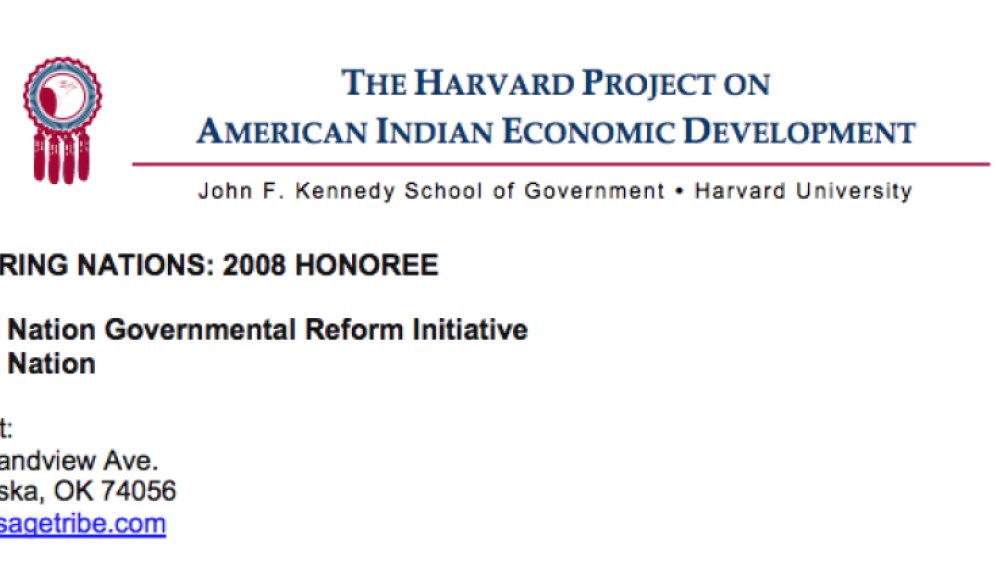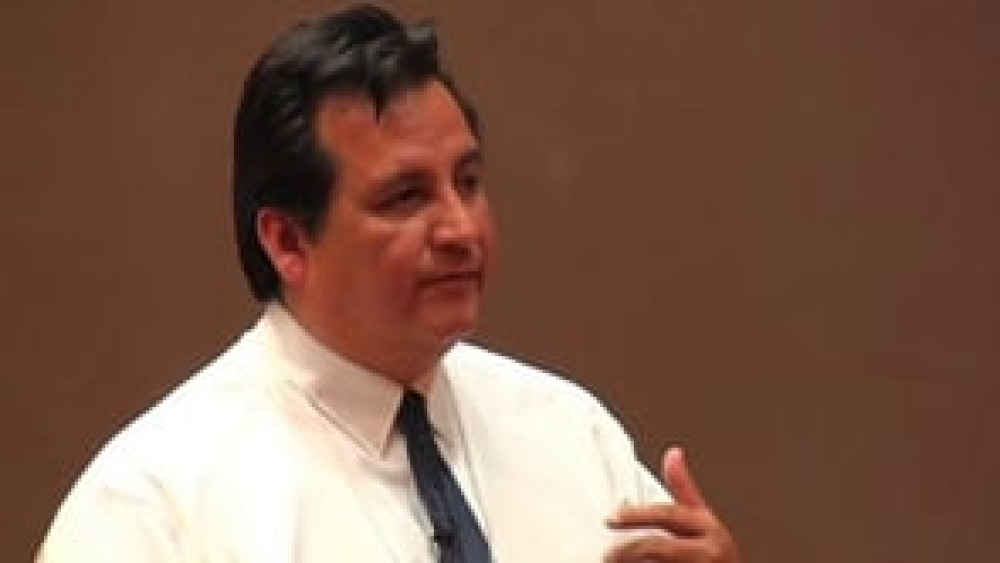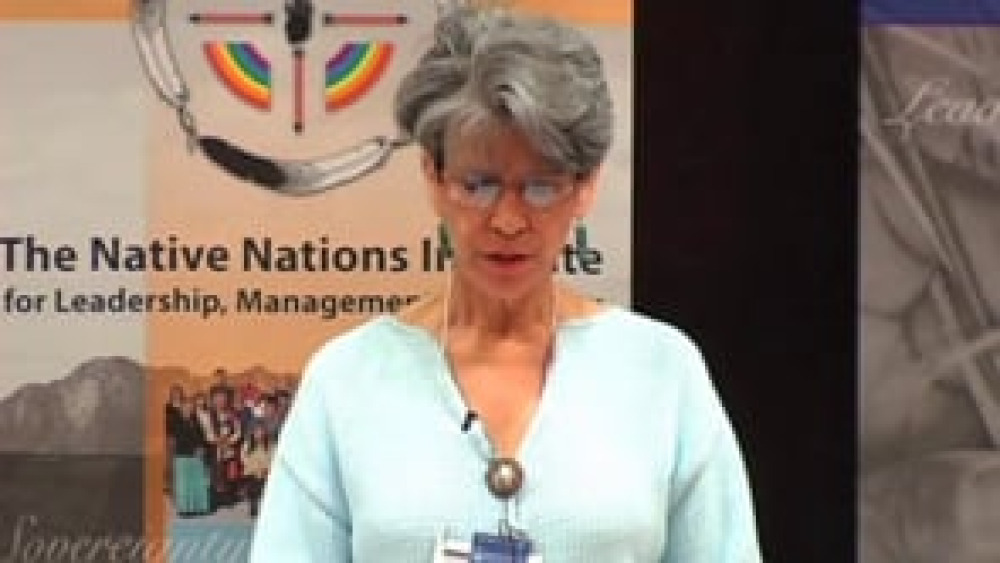Former Osage Government Reform Commission Staff Member Hepsi Barnett discusses the historical events and resulting governance issues that prompted the Osage Nation to create an entirely new constitution and system of government in 2006.
Additional Information
Barnett, Hepsi. "The Osage Government Reform Initiative." Honoring Nations symposium. Harvard Project on American Indian Economic Development, John F. Kennedy School of Government, Harvard University. Cambridge, Massachusetts. September 17, 2009. Presentation.
Transcript
"[Osage Greeting] It is an honor to be here today amongst all of you. And I'll start the presentation by saying that as has been talked about here this morning, often the expression for self-governance for tribes today is the actual ridding ourselves of an illegitimate and imposed system of government that was brought upon by the United States. Certainly in the case of the Osage Nation, that's what prompted our government reform effort. And to provide some context for that, so that you'll understand the problems that we were facing, I think it's important for you to understand that the Osage Nation government first reformed itself in 1881. And obviously with the shifting geo-political occurrences that were happening at that time in the United States with the westward expansion, the Osage Nation found itself -- we had a vast territory in the Ohio and Mississippi Valley. With the Lewis and Clark Expedition, everything began to change for the Osage Nation. Following the expedition and the start of the westward expansion the Osage Nation was, I think, the first Indian agent was Lewis, of Lewis and Clark, and they put the Osages on a reservation, formed Fort Osage. After that the treaties began. The Osages were moved down into Kansas on a reservation. I'm sure you're familiar with Little House on the Prairie, which was actually Little House on the Osage Reservation. All those Indians that you saw surrounding Laura Ingalls, those were Osages. With the obviously, the settlement, the settlers moving into Kansas, the Osage leadership at that time decided that they would work with the federal government to sell that reservation to purchase our present day reservation in Oklahoma. And obviously that was a decision that those leaders, our ancestors at that time, felt was significant. Due to disease, the tribe itself had dwindled down in population. It became clear that in Kansas, settlement was going to happen regardless of the reservation boundaries. At that time, they were moving all of the Indians into Oklahoma, were being resettled in Oklahoma. And Oklahoma was really part of our traditional territory -- it was the southernmost of our traditional territory. So it made sense, given what was going on in the United States at that time, that the Osages would move down into their final homeland in Oklahoma. So we sold our reservation in Kansas, bought our reservation in Oklahoma and that good, wise decision by our ancestors had meant all the difference for us today.
Because we purchased that reservation, it gave us some legal advantages that a lot of tribes in Oklahoma do not enjoy. And one of those advantages is that obviously the mineral rights were also purchased with the surface rights at that time to form our reservation. That became significant probably 20 to 30 years later when oil was discovered on the Osage reservation. At the same time, obviously per capita payments began immediately for Osages and again this is significant -- I know a lot of other tribes share some of this same history -- but for Osages that was significant. When we sold our reservation in Kansas, when we moved to Oklahoma, the BIA [Bureau of Indian Affairs] stepped in and they began leasing lands. Osages at that time really didn't take to farming. I think there was an idea that we would go to Oklahoma and we would start farming. That didn't happen and so we started leasing out lands, with that came per capita payments. And then oil was discovered and the per capita payments obviously increased significantly at that point. At the same time, we're really talking about the turn of the century coming into 1900s. There was talk about opening -- now Oklahoma -- all of Indian territory to settlement with the [1906 Osage] Allotment Act. That was going to hugely impact the Osage Nation.
I should back up just a little bit and say that when we moved to Oklahoma, there was a conscious decision by the tribal leaders at that time to reorganize how we were structured. And they adopted a constitution and a tripartite form of government in 1881. And basically at that time our traditional system of governance was put aside. And obviously I think, I wasn't there but looking back on it you could see that trend begin to happen during that time with a lot of Indian nations. And it, I think in terms of obviously having to create intergovernmental relations with the United States there was some thinking that that was the way to adapt for the future and to really establish ourselves in Oklahoma permanently. So that decision -- with that new form of government and the purchase of our reservation -- really created a situation that when they began to open up Oklahoma for statehood that the Osage Nation was the only tribe that stood in the way of allotment, and that was due to the fact that we owned the land already. So a deal was worked out eventually where all of the other tribes allotted their land -- in the way that you're familiar with -- where every other parcel was opened up for settlement, and every other parcel from that was individual ownership by tribal members. In the Osage reservation, every parcel was distributed to Osage tribal members. So they went around once with a parcel of land, they came around again, at that time there were 2,229 Osages. They came around again and then they came around again. So all of the Osage reservation was allotted, but it was allotted only to Osages and that's again legally significant for us today. I'll try to move forward here pretty quickly.
All of that context is necessary to understand that along with the Allotment Act also came an imposed system of government. So that 1881 tribal reorganization under a constitution that was abolished in 1900, illegally abolished by the United States. And with the Allotment Act was also an imposed tribal council system, very similar to what other tribes got later with the Indian Reorganization Act [IRA]. So from 1906, if you fast forward to 2002, between that period of time there were many efforts by Osage tribal leaders to reassert our sovereignty. All of those were I guess thwarted to a degree because of the 1906 Allotment Act. So legally Osages were exempted out of the IRA, we were exempted out of most other tribal policy. Because if you go back and you look, you'll see that for Osages we have a lot of law specific only to Osages and we have a lot of federal regulations specific only to Osages because of the 1906 Allotment Act. So what that meant is with the changing winds of tribal or Indian policy with the United States, we were not subject to that. Our only, the only thing that [is] really significant in terms of Indian policy that we were almost affected by was termination. There was at one point an effort to terminate the Osage Tribe. We escaped that and when self-governance came into effect, we were exempted out of that.
So if you fast forward to 2004, there was -- the only other thing I'll touch upon is -- there was an effort, a grassroots effort by an organization called the ONOs, Osage Nation Organization, that was a grassroot movement. And they really in the 1960s had, took many trips to Congress, worked with the United States Congress to start to address the injustices that were done in terms of completely eroding our sovereignty with the Allotment Act. Now the only other thing I think is relevant here is that with the 1906 Allotment Act, what happened is as they allotted the land, they also allotted the rights to the royalties that came from the mineral estate. So as you also got a parcel of land, each individual Osage got what is called a head right. And that head right is the property rights to the royalties that came from the mineral estate. How significant was that in the 1920s? The Osage Nation was the richest nation of people in the world because of those mineral rights. That's no longer true despite the rumors, but at that time, during that time, you'll see a lot of history that talks about that period of time for the Osages. We had people like Eleanor Roosevelt visiting, that kind of thing, that often comes with a wealthy nation is also a lot of people that become suddenly very interested in who you are.
With the mineral rights, strangely, was attached the voting rights. So the imposed system of government that we were given by the United States, it did look very much like an IRA government, with the difference being that the only people who could vote were people who had a head right or a portion of a head right. So essentially they created a plutocracy. So during that time, when it was created, everybody got a vote, however many generations down when we got to 2002, two-thirds of Osages were disenfranchised because of that system of government. So the only way you can receive a head right is to inherit a head right. If your parents are alive -- and you're lucky enough to have your parents alive like I am -- my mother has a head right or a portion of a head right, I do not. So for many Osages what that meant is you may be 40, 50, 60, sometimes 70 years old before you actually got to engage with the government or be part of the government -- that's both as an official and as a voter. So you can imagine the division and the strife this caused the Nation over the years. So there were lots of issues that came with that.
There was a court case that was significant that was brought on behalf of Osages by Osages. It's called the Fletcher case. Some of you may be familiar with it because what that case did nationally was it established, firmly established sovereign immunity for tribes. So a lot of other tribal people here are very thankful for the Fletcher case. What it meant for us as Osages is something very different. Because what happened -- as a result of the Fletcher case -- is that upon appeal, the then-tribal council basically was able to undo a government that had been installed that represented all of the people. So Fletcher and a group of Osages brought the case to say that, 'We're all Osages, we should be able to determine who gets to vote,' versus having the United States [determining it]. So it was really attached to membership. And when he took it to court, the court agreed, a new government was installed. So we basically had two governments running parallel at that time: we had the tribal council and we had the new government. On appeal, because of sovereign immunity, the appeals court said that Fletcher could not really bring that case against the tribe itself. They upheld sovereign immunity, which in the long run is very good for everybody. In the short run, for Osages, what it did was after three years of a new government being in place that represented all of the people, overnight it was dismantled yet again.
So after the Fletcher case there was a lot of disharmony obviously in the Osage Nation. With the 31st tribal council, when they came into office in 2002, Principal Chief Jim Gray and some of the other tribal council members led an effort to start to approach the issue of membership -- not through the courts but through building allies in the United States -- and put forth an effort to create some kind of legislative remedy versus a legal remedy there and through the court system. So they were very successful with that. Public law 108-431 was eventually passed in December of 2004. With that, overnight what happened was, the law is very simple and it basically states that the United States reaffirms the inherent sovereign right of the Osage Nation to determine its own membership and its own form of government. So after 100 years we were now, as Chief Gray often likes to say, we looked a little bit like the dog who caught the car. Suddenly we were faced with this tremendous opportunity. There was however a lot of pressure, because like with any society of people, there is always going to be conflict with change. Basically what that tribal council faced and Chief Gray [faced], they had approximately a year to completely reorganize the Osage Nation into a self-governing tribe.
They got to work very quickly after the law was passed. They formed a 10-member independent commission to lead the government reform process. They in turn began to engage the citizenry into what we wanted the new government to look like. First and foremost, I think everybody felt strongly that they wanted a government that was accountable to them. And with that, many conversations began to be had. We reached out not just within our own reservation, because there are Osages that live all across the United States. And there were approximately 25 community meetings held to gather input, there was a survey that was sent out and conducted, there was a referendum. We held a referendum on the very difficult questions; there were approximately 16 questions that we felt like the survey didn't address. One of the primary things being that, what was to come of the tribal council? People felt very strongly [that] they still wanted a body to represent only the shareholders or the head right holders. So those kinds of issues were put forth in a referendum. The results of the referendum were used to design a new constitution, which passed by a two-thirds majority vote in March of 2006. In June of 2006, we held elections for a new government and then they took office in July of that same year. We're actually in the last year of the first term of the new government. It's been a wild ride. I won't say it's been easy. All that talk this morning about, you know, it's sitting around and talking about something is easy enough -- it's a luxury really. But when you actually have to get in there on a day-to-day basis and struggle with a new democracy, it becomes evident why new democracies fail, not just here but around the world.
In closing what I would like to do -- I know I spent most of my time on the problem, I apologize for that. The context was so important for us though so that you all can understand why this story has become so compelling. The other thing I'll say is that one of the boldest things the new government did when they came into office was they started a citizen -- the very first year, there was a citizen-led strategic plan developed. And again, borrowing from what we learned in government reform, in going out to the community and engaging them specifically in the process -- that was repeated in the strategic planning. So we came up with a 25-year strategic plan in the first year of the new government. And that has been really an important move by the new government and has rooted us even more in creating a firm foundation for this level of change.
In closing what I'll do is I'll read to you the preamble that was developed for the Osage Nation Constitution because I think it really sums up the principles and values that became the bedrock of that reform effort.
We the Wah-zha-zhe, known as the Osage People, having formed as Clans in the far distant past, have been a People and as a People have walked this earth and enjoyed the blessings of Wah-kon-tah for more centuries than we truly know.
Having resolved to live in harmony, we now come together so that we may once more unite as a Nation and as a People, calling upon the fundamental values that we hold sacred: Justice, Fairness, Compassion, Respect for and Protection of Child, Elder, All Fellow Beings, and Self.
Paying homage to generations of Osage leaders of the past and present, we give thanks for their wisdom and courage.
Acknowledging our ancient tribal order as the foundation of our present government, first reformed in the 1881 Constitution of the Osage Nation, we continue our legacy by again reorganizing our government.
This Constitution, created by Osage People, hereby grants to every Osage citizen a vote that is equal to all others and forms a government that is accountable to the citizens of the Osage Nation.
We, the Osage People, based on centuries of being a People, now strengthen our government in order to preserve and perpetuate a full and abundant Osage way of life that benefits all Osages, living and as yet unborn.
Thank you."



